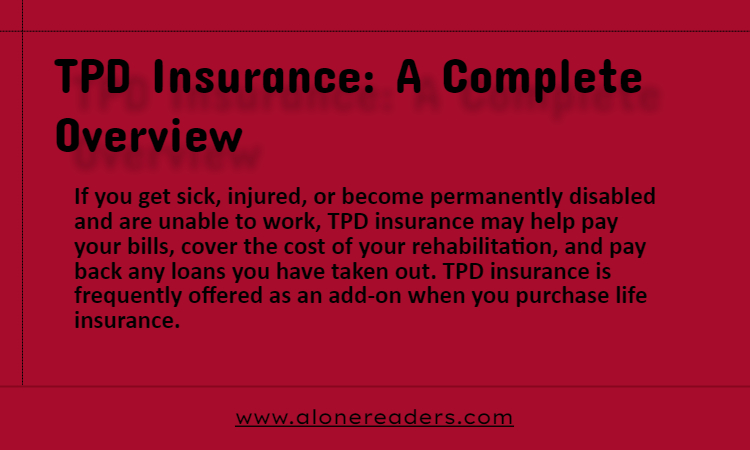
If you get sick, injured, or become permanently disabled and are unable to work, TPD insurance may help pay your bills, cover the cost of your rehabilitation, and pay back any loans you have taken out. TPD insurance is frequently offered as an add-on when you purchase life insurance. Total and permanent disability or TPD insurance can pay you a lump sum (as high as $5 million).
If you become totally and permanently incapacitated and are unable to work as a result of those disabilities, TPD insurance will pay for you. It is intended to assist in recovering lost income, paying for ongoing expenses and payments that would be difficult to pay if you were unable to work as well as medical costs. You may be covered for:
Your own occupation
If your damage prevents you from working at your former position, you may be eligible to file a claim. This insurance is often more expensive and only offered outside super.
Any occupation
If you are unable to find an occupation that is compatible with your education, experience, or training, you may be able to claim this coverage. Because you could still be able to work as a doctor or GP if you were a surgeon before being disabled, TPD insurance is typically less expensive and less likely to pay out.
If the claim results directly or indirectly from an intentional, self-inflicted act by the Life Insured, then neither the TPD insurance nor any included or optional benefits (if applicable) will be paid. The TPD benefit will not be given if you are also qualified for the terminal illness benefit under life insurance if TPD insurance is attached or linked to life Insurance. No payment will be provided under TPD Insurance if it is not attached or linked to life insurance unless the life insured survives the illness or Injury that caused TPD for at least 14 Days.
A very general guideline for estimating how much TPD insurance you could require is to purchase coverage equal to 10 times your yearly pay. Considerations that you should make include:
TPD insurance differs from income protection insurance in the following ways: TPD pays out a lump sum of a policy-specified amount, whereas income protection insurance is designed to replace income and pays out a specified percentage of pre-disability income on a regular basis.
The insured person must be totally disabled on a permanent basis in order for the insurer to pay out, as opposed to just being totally or partially unable to work.
Generally, you have two options for paying for TPD insurance:
Whether you select stepped or level premiums will have a major effect on the cost of your premiums, both now and in the future.
The average monthly cost of TPD insurance is $15.29. Your age, gender, occupation, personal preferences, and condition of health are all factors that will affect the amount you must pay. Since your profession involves more risk than that of "white-collar workers," your insurance premiums will likely be a little more. In the same way, since women live longer than males do, they frequently qualify for cheaper rates.
You should be aware of the following features and benefits of TPD insurance:
Verify your super to see whether you already have TPD insurance. The majority of super funds provide default TPD coverage at a lower cost than purchasing it directly. If necessary, your super fund will let you enhance your level of coverage.
Additionally, you can purchase TPD insurance via:
Both single and life insurance packages are available for TPD insurance. Any amount paid out on a TPD claim, if it's packaged, could lower your life insurance. Ask your insurer or look at the PDS.
Final word
Returning to work after a permanent injury or illness might be challenging or impossible. TPD insurance can act as a safety net to help you and your family by covering expenses like healthcare and rehabilitative care. TPD insurance pays for medical care, prescription medications, specialized therapies, and rehabilitation charges that are not covered by your health fund or Medicare. It also includes paying off responsibilities like a mortgage and monthly living expenses. It is a career or care support.